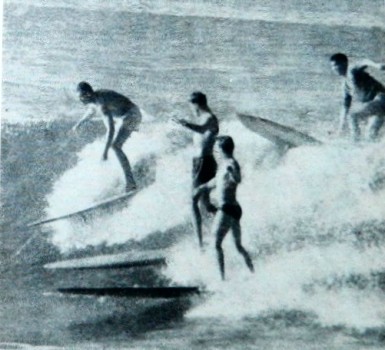
surfresearch.com.au
renwick : winter board riding, 1959
renwick : winter board riding, 1959
|
|
|
|
|
|
 |
surfresearch.com.au
renwick : winter board riding, 1959 |
 |
Weather conditions during the summer cause the surf to be rough and unpredictable. During winter, however, calmer conditions make the surf just right for good board riding.
Right: A
gentle offshore breeze holds up this wave
as John Williams of Avalon corners. |
| ... stay,
because it's the most thrilling, ... the best ...
the most consistent ... and the least interrupted. If your board riding needs improving now's the tune to do it. If you haven't anything to do one weekend get your board out of storage, head for the nearest beach and get into the balancing game. The surf business is now open 52 weeks of the year. Formation of Surf Board Riders' Club Winter surfers' facilities increased from zero to one with the formation of the Surfrider's Club, the ftrst sporting club in Australia to be connected with surfing. It will be run on the same lines as football, racing and other sporting-social clubs. The club has been organised by board designer Gordon Woods and leading rider Bob Evans. Membership is limited to 250. The club's activities will include running surfboard riding competitions, developing a code of ethics for the sport and organising a team to compete in the Hawaiian world board riding championships, held every year at Makaha Beach. |
 Summertime Blues.
Crowded waves like
this one seem to beg for
serious accidents. Less enthusiastic riders give it away in winter, leave more space for the die-hards. |
Australian
Outdoors
July 1959. |
 |
|
|
|
|
|
|